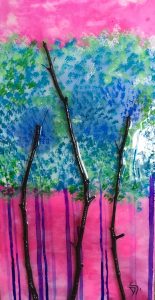Painting Outside (Plein Air Painting) vs Inside the Studio
Category : Arts
 At some point in any of my chats with fellow artists and followers, I get asked whether I prefer to do plein air painting or inside the studio. A silent argument between the two has been lingering on some people’s minds. So let me address that continuing concern here in my blog to give you access about which of the two should be weighed better or does one really matter over the other?
At some point in any of my chats with fellow artists and followers, I get asked whether I prefer to do plein air painting or inside the studio. A silent argument between the two has been lingering on some people’s minds. So let me address that continuing concern here in my blog to give you access about which of the two should be weighed better or does one really matter over the other?
However, before I tackle the issue, I would like to give a few concrete definitions of plein air painting. It is about leaving the four walls of the studio to experience landscape painting. The term “plein air” comes from the French expression “in the open air”. It is a thriving trend in the art world because artists find it a worthwhile and powerful experience.
Difference between Plein Air Painting & Studio Painting
The company
One major difference between plein air painting and studio painting is the company you get. Artists tend to be alone when painting inside the studio, whereas they get to paint with fellow artists when in the field. There is a good advantage to paint with others – it provides a round-table for the free exchange of ideas and constructive on-the-spot criticisms.
Time
Another disparity between the two environments is the time limitation. When you do a plein air painting, you would be working as fast as you could to finish up in the afternoon or right when the colours you want to capture dissolve before your very eyes. Some might do well to finish their works inside the studio bringing with them memories and photographs of the scene outside. Another time-related shortcoming from plein air painting is that you cannot do it all year round. There are seasons in which painting in the open air is not possible. So, if you want to become productive in those months, you can skip putting a lot of weight on plein air painting and get the job done inside your studio.
Visuals
Plein air painters all agree that painting in the open makes them see the colours, light, and shadows on the scene better than in photographs. They say they can even touch the subject, smell its scent, listen to its sound and savour all that it can offer, tendering a total experience that can open up all of your senses. However, studio painters also contest that painting inside gives more opportunity to decide on a design of your own. They can create shapes and values without depending so much on what is in front of them. They can invent colours, light, and shadows that depict their emotions. It gives them the freedom to put in their personal touch and makes their work more interpretative and better adaptations of their selves. You are not ‘couped up’ in a room, but outside breathing fresh air and experiencing the world around you.
Effort
Painting in plein air also requires a huge effort to bring along your ‘stuff’ outdoors. Compared to working inside the studio where you can grab anything at arm’s reach, there is so much energy spent on dragging around heavy art supplies. What if you forget something? Also, if luck does not work in your way, you can encounter bugs, mosquitos, snakes and other unwelcome guests. Remember, you also have the elements – being either exceedingly hot, very cold, windy (which doesn’t mix well with painting), excess sun… the list goes on. However, working outside, in the midst of the warm breezes and bright sunshine, there is totally a sense of freedom in interacting with nature. You can actually breathe fresh air which can improve your motivation. Becoming one with nature is every artist’s inspiration. For some, there is no better way to display the aesthetic and power of nature than to experience it first-hand. Never mind the insects hanging out on their palette, the wind that continuously rocks the easel or the light that changes like every minute or so, painting outdoors gives so much life to certain painters.
I, myself, loved the idea of working in direct contact with my subject, however, I’m a little too practical. I want everything handy and within reach. I always have limited time, so I don’t want to spend time packing up, setting up or travelling. I also don’t want to be rushed – due to fading light or the weather turning. At the end of the day, I think both methods have their distinct and clear advantages; it becomes a personal choice of the artist. What will work for you best?
Check out my artwork for sale here.
